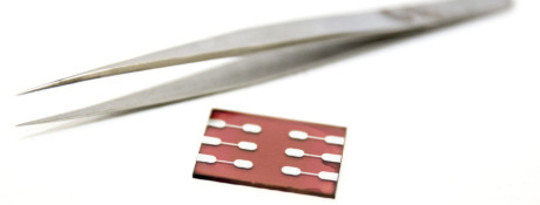
Solar cells made from polymers have the potential to be cheap and lightweight, but scientists are struggling to make them generate electricity efficiently.
A polymer is a type of large molecule that forms plastics and other familiar materials.
“The field is rather immature—it’s in the infancy stage,” says Luping Yu, a professor in chemistry at the University of Chicago.
Now a team of researchers led by Yu has identified a new polymer that allows electrical charges to move more easily through the cell, boosting electricity production.
“Polymer solar cells have great potential to provide low-cost, lightweight, and flexible electronic devices to harvest solar energy,” says Luyao Lu, a graduate student in chemistry and lead author of a paper in the journal Nature Photonics that describes the result.
The active regions of such solar cells are composed of a mixture of polymers that give and receive electrons to generate electrical current when exposed to light. The new polymer developed by Yu’s group, called PID2, improves the efficiency of electrical power generation by 15 percent when added to a standard polymer-fullerene mixture.
“Fullerene, a small carbon molecule, is one of the standard materials used in polymer solar cells,” Lu says. “Basically, in polymer solar cells we have a polymer as electron donor and fullerene as electron acceptor to allow charge separation.”
In their work, the researchers added another polymer into the device, resulting in solar cells with two polymers and one fullerene.
8.2 Percent Efficiency
The group achieved an efficiency of 8.2 percent when an optimal amount of PID2 was added—the highest ever for solar cells made up of two types of polymers with fullerene—and the result implies that even higher efficiencies could be possible with further work.
The group, which includes researchers at the Argonne National Laboratory, is now working to push efficiencies toward 10 percent, a benchmark necessary for polymer solar cells to be viable for commercial application.
The result was remarkable not only because of the advance in technical capabilities, Yu notes, but also because PID2 enhanced the efficiency via a new method. The standard mechanism for improving efficiency with a third polymer is by increasing the absorption of light in the device.
How It Works
But in addition to that effect, the team found that when PID2 was added, charges were transported more easily between polymers and throughout the cell.
In order for a current to be generated by the solar cell, electrons must be transferred from polymer to fullerene within the device. But the difference between electron energy levels for the standard polymer-fullerene is large enough that electron transfer between them is difficult. PID2 has energy levels in between the other two, and acts as an intermediary in the process.
“It’s like a step,” Yu says. “When it’s too high, it’s hard to climb up, but if you put in the middle another step then you can easily walk up.”
The addition of PID2 caused the polymer blend to form fibers, which improve the mobility of electrons throughout the material. The fibers serve as a pathway to allow electrons to travel to the electrodes on the sides of the solar cell.
“It’s like you’re generating a street and somebody that’s traveling along the street can find a way to go from this end to another,” Yu explains.
To reveal this structure, Wei Chen of the Materials Science Division at Argonne National Laboratory and the Institute for Molecular Engineering performed X-ray scattering studies using the Advanced Photon Source at Argonne and the Advanced Light Source at Lawrence Berkeley.
“Without that it’s hard to get insight about the structure,” Yu says. “That benefits us tremendously.”
“This knowledge will serve as a foundation from which to develop high-efficiency organic photovoltaic devices to meet the nation’s future energy needs,” Chen adds.
Source: University of Chicago
Original Study
About the Author
 Emily Conover is a science writer with expertise in physics and astronomy. She writes for the University of Chicago News Office, and her own personal science blog, Weak Interactions, and is available for freelance science or technical writing.
Emily Conover is a science writer with expertise in physics and astronomy. She writes for the University of Chicago News Office, and her own personal science blog, Weak Interactions, and is available for freelance science or technical writing.
Disclosure Statement: The National Science Foundation, Air Force Office of Scientific Research, and US Department of Energy funded the research.
Recommended book:
Green Wizardry: Conservation, Solar Power, Organic Gardening, and Other Hands-On Skills From the Appropriate Tech Toolkit -- by John Michael Greer
 In ancient times, a wizard was a freelance intellectual whose main stock in trade was good advice, supported by a thorough education in agriculture, navigation, political and military science, languages, commerce, mathematics, medicine, and the natural sciences. This book is a must-read for anyone concerned about decreasing our dependence on an overloaded industrial system and, in a world of serious energy shortages and economic troubles, making life a great deal less traumatic and more livable. From the basic concepts of ecology to a plethora of practical techniques, Green Wizardry is a comprehensive manual for today's wizard-in-training.
In ancient times, a wizard was a freelance intellectual whose main stock in trade was good advice, supported by a thorough education in agriculture, navigation, political and military science, languages, commerce, mathematics, medicine, and the natural sciences. This book is a must-read for anyone concerned about decreasing our dependence on an overloaded industrial system and, in a world of serious energy shortages and economic troubles, making life a great deal less traumatic and more livable. From the basic concepts of ecology to a plethora of practical techniques, Green Wizardry is a comprehensive manual for today's wizard-in-training.
Click here for more info and/or to order this book.






















